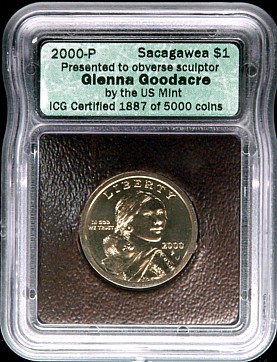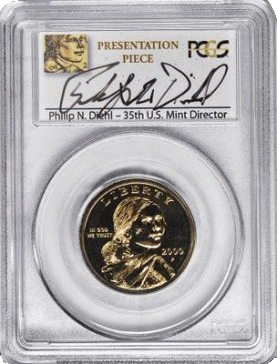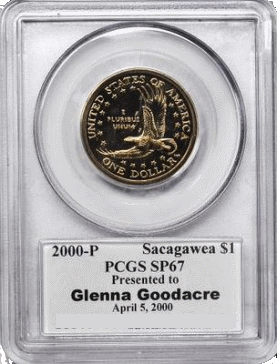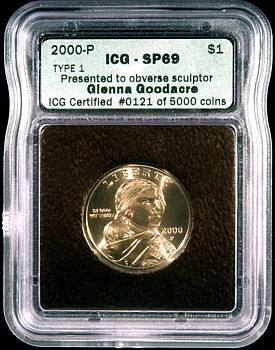ICG reveals Type 1 and
Type 2
Goodacre Sacagawea Specimens
Article by J.P. Martin and Keith Love
© Copyrighted by Independent
Coin Grading Company
Reproduced here with their permission.
ICG is announcing that the US Mint has
released two types of Goodacre Sacagawea Dollars. In
addition to the commonly known burnished Specimens, ICG
has found a little over 2% of the Goodacre Sacagaweas to
be "unburnished." These coins did not receive
the burnishing treatment given to all other Goodacre
Dollars. These unburnished coins reveal special striking
characteristics not found on regular Mint State Sacagawea
Dollars. ICG is now referring to the unburnished and more
rare Sacagawea Dollars as the Type One Goodacre
Sacagaweas. The burnished Specimens are being referred to
as the Type Two Goodacre Sacagaweas. At this time, ICG
has only released the Type Two Sacagaweas and has used
the Type One coins to better research the production
process of all of these coins.
Notice the unburnished coins are
referred to as Type One because all the coins were first
created as Type One coins. The Type Two Sacagaweas came
into existence at a later point in time when
approximately 98% of the Goodacre Sacagaweas were
burnished before being presented to Glenna Goodacre.
We are writing this article to inform
readers of the ICG surface studies of these two types of
Goodacre Specimens, and the conclusion that can be drawn
regarding die and planchet preparation, striking
pressure, and post-strike US Mint burnishing.
ICG became involved with the Goodacre
coins in August of 2000. ICG was contracted by Sacagawea
obverse designer Glenna Goodacre to certify 5,000
Sacagawea Dollars that were presented to her by the US
Mint for payment of her design. This special situation
called for ICG to certify that these were in fact the
Sacagaweas that were presented to Goodacre and for ICG to
number the holders between 1 and 5,000. Before receiving
the special Sacagaweas, ICG had noted in earlier Coin
World reports the US Mint had proudly declared the coins
had been "burnished and rinsed in an antioxidant
solution" before being presented to Goodacre. The
prospect that these coins were in fact burnished meant
that most likely ICG would be unable to grade the
Goodacre Specimens. ICG was left with two tasks. One was
to certify that these coins were the specific coins
presented to Goodacre. The second was to determine what
the US Mint had done to these coins. The language of the
US Mint indicated the US Mint had created a whole new
collectible Sacagawea.
ICG received the coins from Goodacre in
the original mint packaging. Two things became
immediately obvious. The first was the coins were indeed
very "shiny" and had the characteristics of
burnishing. Secondly the coins seemed incredibly well
struck compared to the regular mint state Sacagawea' s
the ICG graders had previously seen.
ICG considers it important to address
and offer evidence regarding the following points:
1. The Goodacre coins were struck on
specially prepared burnished planchets similar to those
used on Proof coins.
2. The Goodacre coins were struck with
higher than normal die pressure.
3. The Goodacre coins were struck from
dies that were finely polished previous to striking.
4. The Type 2 Goodacre coins received
post-strike burnishing at the US Mint.
5. The Goodacre coins received special
post-strike handling that resulted in very few contact
marks.
#1 - The Goodacre coins were
struck on specially prepared burnished planchets similar
to those used on Proof coins. In the striking of
most coins, there is an area that does not completely
strike up. In this area of unstruck planchet one can find
original planchet texture and/or color. On the Sacagawea
Dollar this area is found on the blanket between the
babies head and the designer initials. The best way to
ascertain if the planchets were burnished is to find this
area on the Goodacre coins and look for original planchet
color and texture. The problem with the Type 2
(burnished) coins was even if there was an unstruck area
of planchet on the coins, this area would most likely
have been burnished during the post-strike burnishing
(although areas of light pitting on the original planchet
could escape post-strike burnishing). The Type 1
(unburnished) coins gives us an insight. The unstruck
planchet on business strikes normally displays very small
light colored pitting and is best seen with
magnification. The area of unstruck planchet on the Type
1 coins appears to be shiny and polished in contrast to
the satiny surfaces found on the rest of the coin. This
is a clear indication that the Goodacre Sacagaweas were
struck from specially prepared burnished planchets.
#2 - The Goodacre coins were
struck with higher than normal die pressure.
Comparison of the regular business strikes and a Goodacre
specimen's edges show differences in striking pressure.
The edge beveling is a good indication of this striking
pressure. It is the area near the juncture of the collar
and dies during striking. On proofs this area is squared
and sharp, on business strikes it is more rounded and
beveled. The Goodacre specimen's edges are much sharper
than you would see on regular circulation strike mint
state specimens. These sharp edges can only be associated
with high die pressure that indicates a special striking
situation. Additionally, the dies could not have been in
service very long due to the lack of die erosion.
#3 - The Goodacre coins were
struck from special dies. The Type 1 Goodacres
reveal what could conservatively be called special
surfaces. First of all there is crisp and distinct
die-polish exhibited on each Type 1 coin. This die-polish
is so obvious that it can be seen on some of the Type 2
coins despite the post strike burnishing these coins have
received. ICG has charted die characteristics and can
conclude only one set of dies was used. The lack of die
erosion even on a run of coins as limited as these 5,000
is not unusual as some finely polished mirrored proof
dies can strike up to 1,000 coins without traces of die
erosion.
#4 - The Type 2 Goodacre coins
received post-strike burnishing before being released.
Burnishing can be determined in a number of ways. The
best is to find areas of the coin that would normally
have a different texture than the fields or devices a
coin. Two of these types of areas are bagmarks or areas
of unstruck planchet on a coin. The Type 2 Goodacre
Sacagawea Dollars display characteristics that are only
consistent with post-strike burnishing. The salient issue
is the lack of contrast and texture between the fields
and the bagmarks. Light will reflect differently from the
bagmarks and the fields of a non-burnished coin. Only
post-strike burnishing can cause these bagmarks and the
field to have similar textures and therefore reflect
light in a similar manner. In the case of the Type 2
Sacagawea Dollars, it is obvious that there are bagmarks
that reflect light in a similar manner as the fields.
#5 - The Goodacre coins
received special post-strike handling that resulted in
very few contact marks. Consistent evidence of
minimal contact marks is evidence of special handling.
All of the Goodacre coins are minimally marked, and based
on marks alone, most range from 66 to 69 on the 70-point
scale. Most business strikes average 3 to 5 points lower.
The mint had to have treated the Goodacre Dollars with
extreme care to achieve such results.
ICG was fortunate to be able to compare
the Type 1 (unburnished) and Type 2 coins. Other than the
US Mint employees that made the Goodacre Sacagaweas, ICG
is the only other observer of these groups out of ICG
holders. This helped ICG to address the aforementioned
issues and derive what we believe to be accurate
conclusions. In summary, the Goodacre coins involved:
1. Specially prepared and polished
planchets
2. Specially prepared new die pair
3. High striking pressure
4. Special handling of struck coins
resulting in very few contact marks
5. Type 2 coins were burnished before
being released to Glenna Goodacre
Additionally ICG wanted to address why
ICG did not discover the Type 1 Goodacre Sacagaweas for
over three months. ICG received the Goodacre Sacagaweas
in the original mint packaging that consisted of five
separate groups of 1,000 coins each. ICG did not
immediately holder all the Goodacre coins as Glenna
Goodacre wanted to wait and use the new Lucent Intercept
Shield Gasket for the coins she was keeping personally.
ICG had sealed and shipped 2,000 coins before the Type I
unburnished varieties were found in the third mint
container. Thirteen coins were found dispersed throughout
that container. A search of the remaining two containers
revealed another 110 Type 1 coins for a total of 123 Type
I Goodacres. These coins were intermittently dispersed
throughout these three boxes with no particular
"groups" necessarily together.
ICG considers both types of the
Sacagawea Dollars to be Specimen coins that meet all
requirements of being Proof except for the generally
accepted requirement of being struck twice. Whether the
general numismatic community refers to these as Proof or
Specimen is really open for debate, but we encourage
numismatists to study both Type 1 and Type 2 coins and
regular mint state issues before reaching conclusions.
ICG considers the Type 1 Goodacre Sacagawea to be the
pinnacle of the mint's art form, reminiscent of the satin
proofs that showed the emerging works of Augustus Saint
Gaudens nearly a century ago.
|





